Type a search term to find related articles by LIMS subject matter experts gathered from the most trusted and dynamic collaboration tools in the laboratory informatics industry.
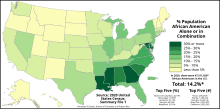 Proportion of African Americans in each U.S. state, the District of Columbia, and Puerto Rico as of the 2020 United States Census | |
| Total population | |
|---|---|
| 46,936,733 (2020)[1] 14.2% of the total U.S. population (2020)[1] 41,104,200 (2020) (one race)[1] 12.4% of the total U.S. population (2020)[1] | |
| Regions with significant populations | |
| 3,552,997[2] | |
| 3,320,513 | |
| 3,246,381 | |
| 2,986,172 | |
| 2,140,217 | |
| 1,820,472 | |
| 1,808,271 | |
| 1,607,581 | |
| 1,478,781 | |
| 1,464,023 | |
| 1,423,169 | |
| 1,376,579 | |
| 1,296,162 | |
| Languages | |
| English (American English dialects, African-American English) Louisiana Creole French Gullah Creole English African languages | |
| Religion | |
| Predominantly Protestant (71 %) including Historically Black Protestant (53%), Evangelical Protestant (14%), and Mainline Protestant (4%); significant[nb 1] others include Catholic (5%), Jehovah's Witnesses (2%), Muslim (2%), and unaffiliated (18%)[3] | |
| Related ethnic groups | |
| Black Canadians, Louisiana Creole people, Gullah people | |
| Part of a series on |
| African Americans |
|---|
 |

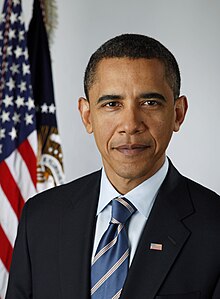
An African American is a person who lives in the United States whose ancestors were from Africa. It could also mean a first generation African immigrant who has citizenship in the United States. Some African Americans are also of Caribbean or Afro-Latino ancestry.[4][5]
The term is usually associated with black people. This is because of many African Americans' dark skin due to having Sub-Saharan African ancestors. Many Africans were brought to the United States in the slave trade. Many of the U.S. population (especially in many urban or city areas) are African American. Many others live in rural areas in the Southern United States. Detroit has the highest percent of blacks in the nation, and many live in other big cities. Cities with the highest percent of African Americans are Jackson, Mississippi; New Orleans; Memphis; Miami Gardens; and Savannah, Georgia.[6] New York City and Chicago have the largest population of African Americans. Other cities with a high African American population are Baltimore, Houston, Atlanta, Philadelphia, Baton Rouge, Washington, D.C. and Dallas. States with the highest percentage of African Americans are Mississippi, Louisiana, Georgia, Maryland, South Carolina, Alabama, Delaware, North Carolina, Virginia and Tennessee. African Americans are third largest ethnic group in the United States after White Americans and Hispanic and Latino Americans. African Americans are the second largest ancestral group in the United States after Germans.[7] Many African Americans have European and Native American ancestry.[8] The first African slaves were brought on a Dutch boat from Angola in 1619 to the British colony of Jamestown in Virginia.[9][10] New York City has the largest African American population by city.[11]
African-American refers to a specific range of diverse cultures with a common thread of ethnic connection to Africa. This term was created to describe an ethnic/cultural link to Africa for people who are American, somewhat like the case of Italian Americans, Irish Americans, or Polish Americans. However, a description based on language may be very different from one based on skin color.
The 'African' in African-American acknowledges the connection to a number of African cultures, not one in particular. The 'American' shows the nationality and culture of the United States. A person born in Nigeria is still Nigerian even if he or she comes to the United States and lives here for the rest of their life. If that person wants to say that they are an American citizen, they would simply say "I am an American citizen". His American-born children might call themselves Nigerian-American OR African-American.
Some Caribbeans such as Jamaicans do not identify as African American, even if they have African ancestry.[12]
In America, and from an American point of view, the term 'Black' is often applied to other ethnic groups throughout the world who do not necessarily see themselves as Black, such as Australian Aborigines, for example. African American culture was born in the United States and is distinct from any single African culture.
African-American is a term that many Black people chose to call themselves because they found the term "Negro" offensive.
In America there are many immigrants of mixed race that includes African descent, like Cape Verdeans, Dominicans, Cubans, Brazilians and Puerto Ricans. These groups, by and large, do not think of themselves as Black or African American and object to these labels.
Many mixed race Americans also resist pressure to identify themselves as Black or White. Blasians (Black Asians) and Afro-Hispanics also resist this pressure.

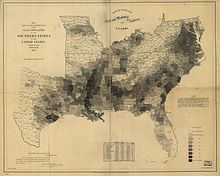

Alabama has a large population of African Americans. African Americans were enslaved in the state.[13]
African Americans constitute 15.4 percent of Arkansas’s population, according to the 2010 census, and they have been present in Arkansas since the earliest days of European settlement. Originally brought to Arkansas in large numbers as slaves, people of African ancestry drove the state’s plantation economy until long after the Civil War. African Americans have exerted a profound influence upon all aspects of the state’s history and culture.
Atlanta was the home of Martin Luther King Jr. and an important place in the Civil Rights Movement.[14] It has been referred to as a "black mecca".[15][16][17]
Delaware has a significant African American population. African Americans were enslaved in the state. In 1721, an estimated 2,000-5,000 black slaves lived in Pennsylvania and the three lower counties on the Delaware.[18]
As of the 2010 U.S. Census, African Americans were 31.2% of Georgia's population.[19]
The first black people to live in Texas were Afro-Mexicans when Texas was a Spanish colony.[20] Texas has one of the largest African-American populations in the country.[21] African Americans are concentrated in northern, eastern and east-central Texas as well as the Dallas, Houston and San Antonio metropolitan areas.[22] African Americans form 24 percent of both the cities of Dallas and Houston, 19% of Fort Worth, 8.1 percent of Austin, and 7.5 percent of San Antonio.[23]
Virginia is home to the longest continuous experience of African American life and culture in the United States spanning more than four centuries – beginning before the first English settlement at Jamestown and through the Revolutionary War, Civil War, Emancipation and the Civil Rights eras.
Outside of the United States, the history of African Americans in Ghana goes back to people such as American civil rights activist and writer W. E. B. Du Bois, who settled in Ghana in the last years of his life and is buried in the capital Accra. Since then, other African Americans who are descended from slaves imported from areas within the present-day jurisdiction of Ghana and neighboring states have applied for permanent resident status in Ghana. As of 2015, the number of African American residents has been estimated at 3,000 people, a large portion of whom live in Accra.
Texas has the largest African American population of any state in 2019. Followed by, Florida, Georgia and New York. The New York City metropolitan area has the largest African American metropolitan population. In 2019, the South had the largest black population by region.[24]
New York City has had the largest number of African Americans by city, followed by Chicago, Detroit, Philadelphia and Houston.[11]
African Americans from north are moving back to the Southern United States and the suburbs.[25] African Americans are moving to smaller cities especially in Fort Worth, Texas, Columbus, Ohio, Jacksonville, Florida and Charlotte, North Carolina.[26]
There is an African American community in Arkansas. African Americans make up 15.4 percent of Arkansas's population.[27]
1.2 million African Americans are lesbian, gay, bisexual or transgendered.[28]
Alabama, Arkansas, Delaware, Georgia, Louisiana, Maryland, Mississippi, North Carolina, South Carolina and Virginia had the largest black population by percentage in 2020.[29]
Many African Americans have European ancestry and Native American along with African ancestry.
Recent surveys of African Americans using a genetic testing service have found varied ancestries. These studies found that on average, African Americans have 73.2–82.1% West African, 16.7%–24% European, and 0.8–1.2% Native American genetic ancestry, with large variation between individuals.[30][31][32]
Genetics websites themselves have reported similar ranges, with some finding 1 or 2 percent Native American ancestry and Ancestry.com reporting an outlying percentage of European ancestry among African Americans of 29%.[33] 38% of African Americans have Irish ancestry.[34]
African American men have the second highest interracial marriage rate, behind Asian American women.[35] Interracial marriage between African Americans and white people has rapidly increased.[36]

Most of the first African Americans were brought to North America as part of the Atlantic slave trade. African slaves were brought to North America from 1619 to 1808. After the United States became independent, slavery became illegal in most northern states. At the same time, slavery grew more important to the economy of the southern states. Many African American slaves worked on plantations (large farms) that grew cotton and tobacco.[37] Plantation work was very difficult and slaves were often whipped and physically punished. It was illegal for slaves to learn how to read and write. White men often raped slave women, but were not punished.[38]
At the same time, there were many free African Americans in the north. Unlike slaves, they were allowed to start churches, write newspapers, and sometimes own property.[39] Frederick Douglass was an important abolitionist (fighter against slavery). Harriet Tubman helped to create the Underground Railroad, which helped African Americans to sneak away from their masters and become free. During the American Civil War from 1861 to 1865, the south broke away from the United States to form the Confederate States of America, or Confederacy. The United States won the war, and in 1865, it freed all slaves (about 4 million) by the 13th amendment.

African Americans were not slaves anymore, but white southerners passed laws called Black Codes that took away their freedom. Some African Americans served in government, but after 1877, the white southerners mostly kept them out of government. Whites founded the Ku Klux Klan to scare African Americans and stop them from voting.[37] Most southern African Americans became sharecroppers. Sharecropping was a system in which the farmers rented the land from the landowner and had to pay the landowner part of their crops.[40] Jim Crow laws segregated white and black people. Black people had to go to different schools and usually live in different neighborhoods than white people. Many businesses were for whites only. The Supreme Court case Plessy v. Ferguson said that black and white facilities could be separate but equal, but facilities for black people were usually worse. Lynching was often practiced against African Americans. White people used lynching to control and terrorize African Americans.[41]
In the early 1900s, African American culture grew with the Harlem Renaissance, an artistic and literary movement in New York City. The NAACP was founded to improve the lives of African Americans. Leaders had different ideas about what was best for African Americans. Booker T. Washington thought they should go to vocational schools to get better jobs. W.E.B. Du Bois thought university education was more important. Marcus Garvey believed that African Americans should move to Africa to have a country of their own.[37] During the Great Migration, from the 1910s to the 1960s, African Americans moved from the south to cities in the north and west. At the beginning, only 10% of African Americans lived outside the south, but by the end, 47% lived in the north and west.[42] Segregation also existed in the north. Redlining stopped people who lived in African American neighborhoods from buying homes.
In the 1950s and 1960s, the Civil Rights Movement called for equality between African Americans and whites. The 1954 Supreme Court case Brown v. Board of Education banned racial segregation in schools. Many Southern schools still stopped black students from attending, until 1957, when federal troops forced a school in Little Rock, Arkansas to allow black students (called the Little Rock Nine). In 1955, Rosa Parks refused to give up her seat on a segregated bus. This started the Montgomery Bus Boycott, which involved Martin Luther King. King and Malcolm X were two leaders of the Civil Rights Movement, but they were both killed in the 1960s. In 1964, the Civil Rights Act banned discrimination based on race.[43]
Racism against African Americans is still prevalent in 2020. In 2020 during the COVID-19 pandemic, George Floyd was killed by a white police officer. Black Lives Matter is a movement which started in 2013.[44]
With their American born children came the first generation of English speaking African Americans. But this development was not the same all over the country. For example; even today the Gullah of the Sea Islands off the Carolina and Georgia coasts still speak a language that is a blend of several African languages. They are the descendants of slaves from different countries in Africa.[source?]
In the United States when Americans say African-American or Black, they are referring to the same people. Both terms describe an ethnic group that came to exist in the United States. The Africans who were brought to America as slaves were from different nationalities and did not all speak the same language. They became a new blended ethnic group with a new language that was not their own: English.[source?]
Blacks used to be segregated in schools but since the 1960s were able to join major schools, colleges and universities. In the second half of the 20th century, reading-ability rates for blacks increased.
In Louisiana, some blacks speak Louisiana Creole, a Creole language similar to French. In the 19th century, the majority of south Louisiana's blacks spoke Louisiana Creole.[45]

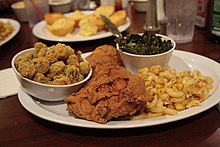
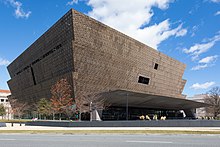
Black culture in the United States is influenced by African, European and Native American cultures.[46] African Americans have influenced various forms of music, including Hip hop, R&B, funk, rock and roll, soul, blues, and other contemporary American musical forms while older black forms of music included blues, doo-wop, barbershop, ragtime, bluegrass, jazz, and gospel music. Michael Jackson, an African-American pop singer, released an album called Thriller in 1982 which is the best-selling album of all time. In the nineties Beyonce Knowles became famous as the lead singer of the R&B girl band Destiny's Child. In the 2000s she started releasing music on her own. Her first album Dangerously in Love sold 11 million copies and won five Grammy Awards.
Black culture has been the subject of documentaries. For example, the award-winning Black Is, Black Ain't explores black identity. Good Hair discusses the significance of having 'good hair' for black women in American culture.
There is a National Museum of African American History and Culture in Washington D.C.[47]
Protestant Christianity is the most practised religion by African Americans.[48]
Soul food is a cuisine eaten by African Americans in the South. Fried chicken, mac and cheese, cornbread, collard greens and candied yams is typical soul food. Soul food has West African, English, French, Caribbean, and Native American influences.[49] African Americans have influenced American cuisine. Staples such as coffee, peanuts, millet, okra, sorghum, watermelon, and yams were brought to America from Africa during the slave trade. African slaves have influenced American dishes such as gumbo and jambalaya.[50] Soul food originated from slavery when European (white) slave owners would feed black people the offal.[51]
Kwanzaa and Juneteenth are popular African American holidays.[52]
White people often considered black people inferior.[53]
African Americans are more likely to experience racism. African American males are more likely to be killed by police, which resulted in the Black Lives Matter movement. African Americans are more likely to die from diseases like COVID-19, HIV, obesity and diabetes. African Americans still suffer from poverty and unemployment. African Americans are more likely to eat fast food. Heart disease, diabetes, cancer, and homicide is the main causes of death for African Americans.[54]
The suicide rate for African Americans increased due to racism, police brutality and the COVID-19 pandemic.[55]
In 2022, a white gunman killed ten African Americans at a grocery store in Buffalo, New York. 32% of African Americans said they worry every day that they might be threatened or attacked because of their race.[56]
African Americans have a harder time getting good jobs because of their race.[57]
55% of African American adults have high blood pressure.[58]
African Americans are more likely to become homeless than whites. African Americans make up 40 percent of the homeless population in the United States.[59]
African Americans are more likely to get punished and arrested for drugs such as marijuana than whites.[60]
African Americans are more likely to experience hunger and lack of access to food.[61]
African Americans are more likely to catch monkeypox and less likely to receive vaccines for the disease.[62]
Colorism is also prevalent in the black community today. Lighter skinned blacks and mixed race blacks are often treated better than dark skinned blacks. Colorism originated during slavery. White slave masters treated mixed-race slaves better than monoracial dark skinned black slaves. Light skinned black slaves were thought of as more intelligent and beautiful.[63]
{{cite web}}: Missing or empty |title= (help)